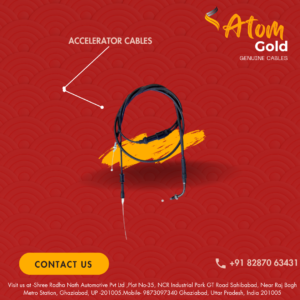Understanding the accelerator cable function and maintenance is essential for keeping your vehicle performing at its best. The accelerator cable plays a critical role in translating the driver’s foot movement into engine acceleration, directly impacting how your car responds to throttle inputs. In this article, we’ll explore the function of the accelerator cable, its importance to your vehicle’s performance, and tips for effective maintenance to ensure its longevity and reliability.

The Basics of Accelerator Cables
Function: An accelerator cable transfers the driver’s foot movement on the accelerator pedal to the throttle body or carburetor. Consequently, this action regulates the engine’s power output by controlling the mixture of air and fuel that enters the engine. Therefore, understanding accelerator cable function and maintenance is crucial for ensuring optimal vehicle performance.
Construction: Typically, manufacturers make accelerator cables from high-tensile steel wire for durability and strength. This wire, in turn, encases itself in a protective outer sheath that shields it from dirt, moisture, and abrasion. As a result, the cable enjoys a long service life and smooth operation. Moreover, regular maintenance helps prevent wear and tear. For this reason, it is essential to monitor the condition of your accelerator cables periodically.
Operation: When you press the accelerator pedal, the cable pulls on a lever connected to the throttle body or carburetor. Consequently, this lever opens the throttle valve, allowing more air to flow into the engine. Subsequently, the engine control unit (ECU) or carburetor adjusts the fuel mixture, which, in turn, increases the engine’s power output and speed. Thus, proper accelerator cable function and maintenance ensure that the engine responds accurately to driver inputs.
Key Components of Accelerator Cables
Inner Cable: The inner cable consists of a flexible, high-tensile wire that directly transmits the mechanical motion from the accelerator pedal to the throttle mechanism. It needs to be strong yet flexible to endure constant movement without breaking. Therefore, regular inspection, as part of accelerator cable maintenance, is essential to prevent unexpected failures.
Outer Sheath: The outer sheath surrounds the inner cable and acts as a protective casing. Made from durable materials like plastic or rubber, it shields the inner cable from environmental damage and reduces friction. Consequently, maintaining the outer sheath is a key aspect of accelerator cable function and maintenance. Additionally, replacing a damaged outer sheath promptly can prevent further issues.
Cable Ends: The ends of the accelerator cable connect to the accelerator pedal and the throttle mechanism. These ends often include adjustable components that fine-tune the cable’s length and tension for precise control. Therefore, proper adjustment is crucial for effective accelerator cable maintenance. Furthermore, ensuring these connections are secure enhances the overall performance.
Types of Accelerator Cables
Single Cable Systems: In these systems, a single cable connects the accelerator pedal directly to the throttle. This design commonly appears in older vehicles and simpler engine configurations. On the other hand, modern vehicles frequently use dual cable systems to improve performance.
Dual Cable Systems: Modern vehicles often employ dual cable systems, where one cable is responsible for opening the throttle (pull cable) and another for closing it (push cable). This setup provides improved control and reliability, thereby preventing the throttle from sticking open. Understanding the type of system can, therefore, aid in effective accelerator cable function and maintenance.
Common Issues and Maintenance
Cable Wear and Tear: Over time, the inner cable can fray, and the outer sheath can degrade. Consequently, regular inspection and timely replacement of worn cables become essential to prevent sudden failures and ensure smooth accelerator operation. Effective accelerator cable maintenance can significantly mitigate these issues.
Sticking or Binding: Additionally, dirt, rust, or damage to the cable or sheath can cause sticking or binding, which leads to poor throttle response. Regular cleaning and lubrication, or replacing damaged cables, resolve these issues and improve accelerator cable function.
Adjustment: Proper adjustment of the accelerator cable’s tension is crucial. For instance, a cable that is too loose can result in delayed throttle response, while one that is too tight can cause high idle speeds or difficulty in controlling the engine speed. Therefore, periodic adjustments ensure optimal performance and are an important part of accelerator cable maintenance.
Importance of Quality Cables
Using high-quality accelerator cables is vital for maintaining vehicle performance and safety. Inferior cables, on the other hand, can lead to frequent replacements, erratic throttle response, and even safety hazards. At Atom Gold Cables, we manufacture superior automotive cables that ensure reliability and longevity. Our cables withstand harsh conditions and deliver consistent performance, making them a trusted choice in the automotive industry.
Conclusion
Accelerator cables play a fundamental role in the proper functioning of your vehicle’s throttle system. Regular maintenance and timely replacement of worn or damaged cables ensure smooth and responsive engine performance. By understanding accelerator cable function and maintenance, you can better appreciate the engineering behind your vehicle and the necessity of using quality components.
For superior automotive cables, trust Atom Gold Cables—your reliable partner in delivering excellence and performance in the automotive industry. With 35 years of experience, Atom Gold Cables ensures the highest quality standards for all your vehicle needs.
Read our Articles at Medium.com
